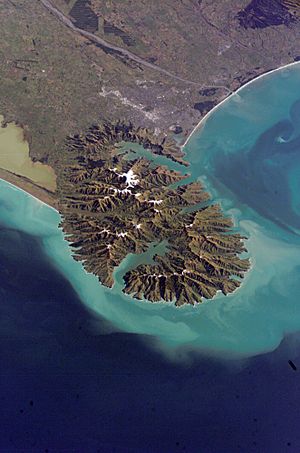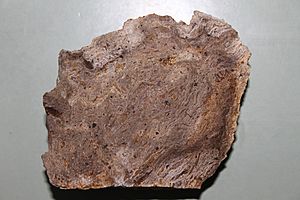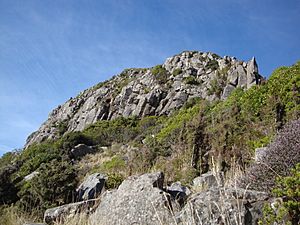Banks Peninsula Volcano facts for kids
Quick facts for kids Banks Peninsula VolcanoStratigraphic range: Late Miocene, ~11–5.8Ma |
|
|---|---|

Banks Peninsula with Akaroa Harbour (West, Lower) and Lyttelton Harbour (East, Upper)
|
|
| Type | Volcanic Complex |
| Sub-units | Diamond Harbour Volcanic Group, Mount Herbert Volcanic Group, Akaroa Volcanic Group, Lyttelton Volcanic Group |
| Overlies | Torlesse Composite Terrane and Mount Somers Volcanics |
| Thickness | Originally c.1500m |
| Lithology | |
| Primary | Basalt |
| Other | Andesite, trachytes and rhyolite |
| Location | |
| Coordinates | 43°44′S 172°51′E / 43.733°S 172.850°E |
The Banks Peninsula Volcano is an extinct volcano located east of Christchurch on New Zealand's South Island. This means it is a volcano that is no longer active and won't erupt again. Even though it's very old and worn down by weather, it still makes up most of Banks Peninsula. Its highest point is about 919 meters (3,015 feet) tall.
This volcano is actually made up of two main eruption spots. One was near Lyttelton Harbour, and the other was near Akaroa Harbour. The eruptions mostly produced a type of dark volcanic rock called basalt. There were also smaller amounts of other rocks like andesite, trachyte, and rhyolite. The volcano was active a very long time ago, during the Late Miocene period, which was about 11 to 5.8 million years ago.
After the Christchurch earthquakes, some people worried the volcano might erupt. However, scientists say there is no magma (molten rock) chamber under the volcano. There have been no signs of volcanic activity for the last 5 million years. So, it's definitely extinct!
Contents
How the Banks Peninsula Volcano Formed
New Zealand's South Island has many extinct volcanoes, and scientists aren't always sure why they formed. These volcanoes are called "intraplate volcanoes" because they don't sit on the edges of tectonic plates where most volcanoes are found. They range in age from the Cretaceous period to the Pliocene period. You can find them in areas like Otago, Canterbury, and on the Chatham Islands.
The Banks Peninsula Volcano is the largest of these old volcanoes. The Dunedin Volcano is the next biggest, but it's only half the size. Other old volcanoes, like the Mount Somers Volcanics from the Cretaceous period, are also found in Canterbury, including parts of Banks Peninsula.
These volcanoes can be quiet for millions of years between eruptions. This suggests that their formation is linked to the Earth's lithosphere (the rigid outer layer of the Earth). This is different from volcanoes like those in Hawaii, which are fed by hot spots deep within the Earth.
One idea for how these volcanoes formed is that parts of Zealandia's lower lithosphere broke off and sank into the hotter layer below, called the asthenosphere. Zealandia is the continent New Zealand sits on, and its lithosphere is quite thin because it stretched out as it moved away from Australia. If large pieces of this thin lithosphere sank, hotter rock would rise to fill the space. This hot rock could then melt, causing volcanic eruptions over many millions of years.
The Shape of the Volcano
The shape of the Banks Peninsula Volcano was influenced by cracks in the Earth's crust, called faults. These faults ran from the northwest to the southeast and guided where the magma flowed. This is how the Lyttelton Volcanic Complex formed.
Over millions of years, erosion (wearing away by wind and water) has shaped the volcano. Streams formed in a star-like pattern around the old volcanic cones. Where these streams met, larger valleys formed. When one side of a volcanic cone eroded away, it created bigger catchment areas (areas where water collects). This process helped create the large, natural harbours we see today on Banks Peninsula. For example, Lyttelton Harbour started to form about 8.1 million years ago.
The hard, strong volcanic rock that makes up Banks Peninsula has also played a big role in shaping the nearby Canterbury Plains.
Different Parts of the Volcano
The volcanic activity at Banks Peninsula started near Lyttelton Harbour about 11 million years ago. Then, it moved east through the Mount Herbert Volcanic Group towards Akaroa Harbour, around 9 million years ago. During the later stages, both main magma chambers (at Akaroa and Lyttelton) were active at the same time.
The chemistry of the lava changed over time, and the volcano had cycles of eruptions. In each cycle, the amount of a mineral called feldspar in the lava increased. This made the lava thicker and created more blocky lava flows.
Lyttelton Volcanic Group

The very first eruptions of the Banks Peninsula Volcano happened between 11 and 9.7 million years ago, in the area where the town of Lyttelton is now. These old volcanic rocks sit on top of even older rocks from the Mount Somers Volcanic Group and the Rakaia Terrane. The Lyttelton Volcanic Group is mostly made of basalt. It was built up from five volcanic cones that overlapped each other.
One part of this group is called the Allandale Rhyolite. It's made of rhyolite and dacite lava flows that have bands of different colors. You can also find rare pieces of tuff (volcanic ash) and obsidian (volcanic glass) from about 10.8 million years ago. Above the Allandale Rhyolite, you'll find the Governors Bay Andesites in the Lyttelton Harbour area.
Mount Herbert Volcanic Group
The Mount Herbert Volcanic Group was active between 9.7 and 8 million years ago. This group shows that the volcanic activity was moving towards the east during this time.
Akaroa Volcanic Group
The Akaroa Volcanic Group was active between 9 and 8 million years ago. It consists of basaltic to trachytic lava flows that were centered around Akaroa Harbour.
Diamond Harbour Volcanic Group

The Diamond Harbour Volcanic Group represents a return of volcanic activity to the western side of the peninsula. This happened between 7 and 5.8 million years ago. This group is mostly made up of basalt, with some rare layers of carbon-rich mud found within the rock.

